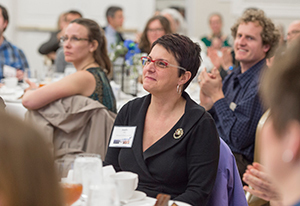 Jennifer Tank at the 2016 Rodney F. Ganey Award dinner
Jennifer Tank at the 2016 Rodney F. Ganey Award dinner
Jennifer Tank has received the 2016 Rodney F. Ganey, Ph.D., Community-Based Research Award for working together with Kosciusko County farmers and local conservation staff to reduce nutrient runoff in the Shatto Ditch watershed. The award is a $5,000 prize presented annually to a regular faculty member at the University of Notre Dame who has completed at least one research project that addresses a need within South Bend or the surrounding area.
For decades, farmers have added fertilizers to their soils to help maximize crop yields and profits. But nutrients that crops do not incorporate eventually run off into surrounding streams and rivers where they can cause serious problems. Excess nutrients such as nitrogen and phosphorus can change the character of water, even altering its biology so that it harms freshwater ecology and ultimately becomes undrinkable.
When Jennifer Tank, Galla Professor of Biological Sciences, began to research the problems of nutrient runoff in nearby Kosciusko County, she focused on the streams and rivers it affected. She soon realized that the problems extended beyond streams and rivers, and that they would require her to expand the scope of her research well beyond their banks. As Tank put it, “I needed to get out of the streams and rivers and talk with farmers, but farmers didn’t necessarily want to hear from a biologist about what nutrient runoff was doing to freshwater.”
Tank understood the farmers’ skepticism and empathized with them. “Agriculture feeds the world and farmers need to make a living in a competitive business,” she said. “I couldn’t go to them with solutions that asked them to sacrifice crop yields and profits.” She realized that if the insights she was garnering in her research were to prove practically useful, she would need to gain the trust of Kosciusko County farmers and come up with solutions that were good for both crops and water. She would need to do both science and politics, biology and relationship building.
In Indiana’s neighboring states, soil and conservation efforts have worked through state legislation to regulate farming in ways that have put new constraints on agriculture and created tension between farmers, conservationists and legislators. Tank was searching for social and scientific solutions that would lead to positive results for all parties, but she had to work overcome the obstacles of miscommunication and natural skepticism.
After many careful conversations with conservationists and farmers, Tank began to see herself less as a scientist offering solutions and more as a partner working on a common set of problems. The farmers she became acquainted with were sincere stewards of their land and did not intend to harm water, but they did not want to be told what to do and have their own wisdom and experience with land use disregarded. They wanted to be involved in developing a good solution that satisfied everyone.
In fact, the wisdom and experience of Kosciusko County farmers made them excellent scientific partners. “Farmers are naturally experimentalists,” said Tank. “Many of them have spent years analyzing data and results and trying to come up with better ways to do things.”
One of the methods that farmers have long used to protect land in the offseason — when fields would normally be bare — proved valuable to Tank’s work. During the winter and spring, farmers often plant what are called cover crops, which are planted in late fall to slow erosion and improve soil health over the winter and spring before the next year’s cash crop planting occurs.
Although Kosciusko County farmers were using cover crops more than on average for Indiana, this planting still amounted to a very low percentage of the land in the surrounding Shatto Ditch watershed. Tank and her collaborators believed that if they increased that percentage, they might keep more nutrients in the soil, instead of having them run off into streams and rivers where they harm freshwaters and do not benefit crops.
In Indiana, cover crops are currently used on average on less than 15 percent of land that can be used for crops, and that is considered high compared to the national average. Kosciusko County farmers in the Shatto Ditch watershed are now growing winter cover crops on about 70 percent of their acreage, a rate that has already significantly reduced the amount of nutrient runoff to local waterways while increasing fertilizer nutrients in soils, which farmers hope will lead to higher crop yields.
The Ganey Award is funded by local entrepreneur and philanthropist Rodney F. Ganey, Ph.D., and awarded by the University of Notre Dame’s Center for Social Concerns. The center facilitates community-based learning, research and service for Notre Dame undergraduates, graduate students and faculty. Since 1983, more than 15,000 students and hundreds of faculty have been engaged in its courses, research and programs.
Contact: JP Shortall, Center for Social Concerns, 574-631-3209, james.p.shortall.1@nd.edu
Originally published by JP Shortall at news.nd.edu on April 12, 2016.